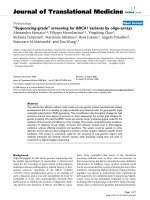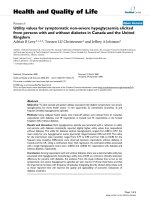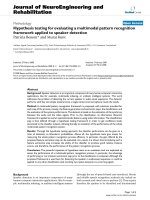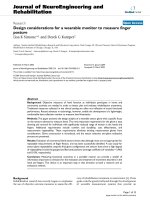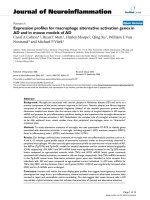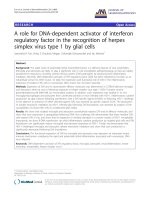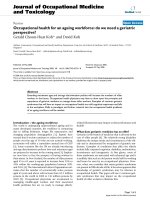báo cáo hóa học:" "Sequencing-grade" screening for BRCA1 variants by oligo-arrays" docx
Bạn đang xem bản rút gọn của tài liệu. Xem và tải ngay bản đầy đủ của tài liệu tại đây (1.51 MB, 7 trang )
BioMed Central
Page 1 of 7
(page number not for citation purposes)
Journal of Translational Medicine
Open Access
Methodology
"Sequencing-grade" screening for BRCA1 variants by oligo-arrays
Alessandro Monaco
1,4
, Filippo Menolascina
2,4
, Yingdong Zhao
3
,
Stefania Tommasi
4
, Marianna Sabatino
1
, Ross Fasano
1
, Angelo Paradiso
4
,
Francesco M Marincola
1
and Ena Wang*
1
Address:
1
Department of Transfusion Medicine, Clinical Center, National Institutes of Health, Bethesda, MD, USA,
2
Department of Bioinformatics,
University of Bari, Italy,
3
Biometrics Research Branch, National Cancer Institute, National Institutes of Health, Bethesda, MD, Italy and
4
Clinical
Experimental Oncology Laboratory, Istituto Tumori IRCCS "Giovanni Paolo II", Bari, Italy
Email: Alessandro Monaco - ; Filippo Menolascina - ; Yingdong Zhao - ;
Stefania Tommasi - ; Marianna Sabatino - ; Ross Fasano - ;
Angelo Paradiso - ; Francesco M Marincola - ; Ena Wang* -
* Corresponding author
Abstract
The need for fast, efficient, and less costly means to screen genetic variants associated with disease
predisposition led us to develop an oligo-nucleotide array-based process for gene-specific single
nucleotide polymorphism (SNP) genotyping. This cost-effective, high-throughput strategy has high
sensitivity and the same degree of accuracy as direct sequencing, the current gold standard for
genetic screening. We used the BRCA1 breast and ovarian cancer predisposing gene model for the
validation of the accuracy and efficiency of our strategy. This process could detect point mutations,
insertions or deletions of any length, of known and unknown variants even in heterozygous
conditions without affecting sensitivity and specificity. The system could be applied to other
disorders and can also be custom-designed to include a number of genes related to specific clinical
conditions. This system is particularly useful for the screening of long genomic regions with
relatively infrequent but clinically relevant variants, while drastically cutting time and costs in
comparison to high-throughput sequencing.
Background
High throughput $1,000 whole genome sequencing may
be rapidly approaching[1,2], meanwhile, a clinical need
exists for the screening of genes whose polymorphisms
determine disease predisposition, natural history or ther-
apeutic outcome. Screening of the BRCA1 (OMIM
113705) cancer predisposition genes is an example of
such a situation and it was well exemplified by [3,4] by
Gerhardus et al [5], who systematically reviewed 3816
publications to estimate the accuracy of diagnostic meth-
ods used for the detection of BRCA1 and BRCA2 muta-
tions. They concluded that many of the alternative
screening methods were as time- and cost-intensive as
direct sequencing, but did not provide the same definitive
information. In addition, many of these methods could
not be recommended for routine screening because of low
sensitivity. Denaturing high-performance liquid chroma-
tography was shown to outperform other methods but
still required to be complemented by sequencing. Signifi-
cantly, none of the techniques evaluated in the study,
including direct sequencing, could detect large rearrange-
ments, such as whole exon germline deletions/insertions.
Published: 30 October 2008
Journal of Translational Medicine 2008, 6:64 doi:10.1186/1479-5876-6-64
Received: 15 August 2008
Accepted: 30 October 2008
This article is available from: />© 2008 Monaco et al; licensee BioMed Central Ltd.
This is an Open Access article distributed under the terms of the Creative Commons Attribution License ( />),
which permits unrestricted use, distribution, and reproduction in any medium, provided the original work is properly cited.
Journal of Translational Medicine 2008, 6:64 />Page 2 of 7
(page number not for citation purposes)
Germline mutations in BRCA1 account for a small but sig-
nificant proportion of breast cancers. Genetic testing has
been routinely applied to women from high risk families
since 1994 [6,7]. BRCA1 spans an approximately 81 Kb
region encompassing 24 exons (22 coding), and so any
screening method must confront the challenge of moni-
toring this large genomic region over which the relevant
variants are scattered[8] (Figure 1). Sequencing using semi
high-throughput Sanger sequencing technology remains
the gold standard for evaluating the BRCA1 gene despite
its relatively high cost and time commitment[5].
Results and discussion
We used a previously described flourimetric SNP detec-
tion strategy based on the proportional hybridization of
test and reference material with an oligonucleotide array
platform [9] to design a BRCA1-specific array covering the
entire coding region. This array was capable of detecting
SNPs and/or gene rearrangements (insertions and dele-
tions), even in heterozygous conditions. At reasonable
cost, we used sequence-specific probes to query hundreds
of kilobases within a single reaction. The array design
included 1,423 consensus oligo probes arranged at 4-
nuclotides tiling based on arbitrarily selected wild type
BRCA1 reference sequence [9] to cover all the exonic
regions of BRCA1 and part of the intronic regions (Table
1). Oligo probes were designed in variable size (from 18
nucleotide to 25) to maintain constant the melting tem-
perature [10-12]. In addition, 38 exonic and 31 intronic
oligo-probes representing known variants of BRCA1 were
designed according to Ensembl SNP database http://
www.ensembl.org where the variant SNP was placed in
Chromosomal location and genomic mapping of the BRCA1 locus and sub-fragments amplified for genomic analysisFigure 1
Chromosomal location and genomic mapping of the BRCA1 locus and sub-fragments amplified for genomic
analysis. The correct size for each amplicon is shown in the lower panel.
Journal of Translational Medicine 2008, 6:64 />Page 3 of 7
(page number not for citation purposes)
the centermost position of the probe to enhance the spe-
cificity and discriminative power of the hybridization[9].
An arbitrarily-selected wild-type sequence was derived
from Ensembl database
. Refer-
ence sample consisted of genomic DNA extracted from
MCF-10A, a mammary epithelial cell line previously
shown by sequencing to be homozygous at the BRCA1
locus. The sequence of the BRCA1 gene in MCF-10A was
not completely identical to the wild-type consensus
sequence but represented the closest available match.
Probes with 3'amine modification were spotted onto a
3D-link-activated array slide by covalent immobilization
(GE Healthcare) using OmniGrid robotic printer (Gen-
eMachine). Genomic DNA was extracted using Qiagen
blood extraction kit. PCR amplification was performed
using Phusion polymerase (F-530L, Finnzymes) accord-
ing to company instructions. Eleven primer sets were used
to amplify the entire coding region and parts of the
intronic regions (Figure 1). A T7 promoter sequence was
attached to the 5' end of each forward primer to allow sub-
sequent in vitro transcription. After denaturing at 98°C for
30 sec, PCR reactions were cycled 30 times at 98°C for 7
sec, 68°C for 20 sec, 72°C for 2 min followed by 72°C for
2' 30". The PCR amplicon size was confirmed using an
Agilent 2100 bioanalyzer (Figure 1, bottom panel). Three
microliters of each amplicon from the same patient were
combined together and purified with a Microcon YM-100
spin column (Millipore, Bedford, MA) to remove primers.
Eight microliters of the total volume (30 ul) of the puri-
fied PCR BRCA1 amplicon mixture from each patient was
subjected to in vitro transcription using T7 Megascript kit
(Ambion). The reaction was run for 8 hours at 30°C. Iso-
lation of amplified RNA (aRNA) was performed by TRI-
ZOL purification. Three micrograms of purified aRNA
were fluorescently-labeled with a reverse-transcription
reaction in the presence of 2 μg of random hexamer, 5 μl
4× first-strand buffer, 2 μl 0.1 M DTT, 1 μl RNasin, 2 μl of
5 mM low T dNTP, 2 μl of 2 mM Cy3 (reference sample)
or Cy5 (test sample) dUTP (Amersham, Piscataway, NJ)
and 2 μl of SSII (Invitrogen). Labeled cDNA were purified
and co-hybridized on to BRCA1 chip in the presence of
blocking reagents after denaturing. Hybridized arrays
were scanned at 10 μm resolution on a GenePix 4000
scanner (Axon Instruments, Inc., Foster City, CA) at varia-
ble PMT voltage to obtain maximal signal intensities with
<1% probe saturation. Resulting tiff-format images were
analyzed to calculate fluorescence intensities and log2
Ratio values, which were normalized and portrayed
graphically[9] (Figure 2).
A specific pattern can be seen which denotes the presence
of a SNP. The feature of this pattern is characterized by the
red signal deflection (Cy5) representing the specific
hybridization of the test sample to the oligo-probe for the
specific SNP and a flanking region green signal (Cy3)
deflection including overlapping wild type consensus
oligo-probes for each side around the SNP. Homozygous
samples will hybridize more strongly and have higher red
and green fluorescent intensity as compared to hetero-
zygous samples (see also Figure 3B). In addition, the pres-
ence of green deflections (Cy3) in consecutive probes
flanking the region of a putative unknown variant would
indicate the presence of a novel SNP if no corresponding
red spike (Cy5 SNP-specific probe) could be detected in
that region to indicate a known specific variant.
To evaluate the sensitivity and specificity of the process,
we compared results obtained with the oligoarray against
those from direct sequencing. As part of an ongoing clini-
cal protocol, samples for BRCA1 and BRCA2 mutational
analysis were obtained from 85 consecutive patients with
familial breast and/or ovarian cancer[13]. Patients were
seen and signed informed consent at the Genetic Counsel-
ling Program, Clinical Oncology Laboratory, at the Bari
National Cancer Institute (DNV Certificate N. CERT-
17885-2006-AQ-BRI-SINCERT). Only patients classified
as having a higher than 10% probability of carrying a
BRCA1 or BRCA2 mutation were enrolled. This risk was
calculated using the New Myriad II program, which refer-
ences an individual's TNM classification U.I.C.C., cyto-
histological differentiation grade, estrogen receptor (ER)
and progesterone receptor (PgR) status, tumor content
and whether there is a history of breast or ovarian cancer
among relatives.
Fragment 4 of the BRCA1 locus contains several SNPs
associated with the predisposition for developing breast
Table 1: Estimated cost and time requirements for typing of the BRCA1 gene by direct sequencing vs SNP array
Consumables
supplies
Equipment Personnel cost/react Total Cost/sample
BRCA1 gene
(35 fragment)
Time Time/20 samples
Direct
sequencing
$11.30 $7.30 $10.08 $28.68 $1,003.80 approx 2 working
days
approx 20
working days
SNP array $38.74 $12.50 $8.30 $59.54 $59.54 less than 3
working days
less than 3
working days
Journal of Translational Medicine 2008, 6:64 />Page 4 of 7
(page number not for citation purposes)
and ovarian cancer and was used for SNP analysis and val-
idation by direct sequencing (Figure 2). To demonstrate
the principle, data were portrayed for individual frag-
ments (sub-arrays) after fragment-specific normalization
to graphically display the presence of SNPs along the
sequence (as previously described[9]; Figure 2). Consist-
ent calls identifying SNPs present in the reference sample
(that was not completely identical to the wild-type con-
sensus sequence) in all cases were excluded from the anal-
ysis because representative of variations in the reference
MCF-10A cell line and not related to the test sample. This
fragment-specific normalization corrects sequence-spe-
cific and amplicon-specific variation in intensity that may
cause imbalanced hybridization as tested using sequence
identical samples differentially labeled and hybridized on
the same chip for calibration purposes (see example in
Figure 2, top panel). This normalization does not affect
the intra-fragment reference/test ratio measurements.
A custom made software SNPpositioner uses an algorithm
that queries the Graphical User Interface to select pre-
determined chromosomal regions relevant to the analysis
(individual fragments in this case). Probe logRatio were
first averaged from duplicated spots followed by the
"Local Amplicon-oriented Normalization Algorithm"
(LANA). This LANA approach is used to sort individual
probes implementing the two nearest flanking probes
summarized below:
Representative example of the graphical representation of SNPs for Fragment 4 in three patients' samplesFigure 2
Representative example of the graphical representation of SNPs for Fragment 4 in three patients' samples.
The yellow symbols (Star, Hexagon, Square) relate to cases shown in Figure 3A.
Journal of Translational Medicine 2008, 6:64 />Page 5 of 7
(page number not for citation purposes)
T(log Ratio
i
) = 2*log Ratio
i
- log Ratio
i-1
- log Ratio
i+1
Data analysis, therefore, is performed blindly and auto-
matically to identify variant sequences when the trans-
formed Cy5/Cy3 logRatio [T(logRatio)] of a probe is
above and/or below a fragment-defined baseline cutoff
value which is two standard deviations in the current set-
tings. This algorithm objectively identifies sequence varia-
tions without any subjective manipulation the oligo-array
data. The analysis was carried out blind (only the refer-
ence was completely sequenced for the BRCA1 locus) and
it was automated using our custom software that made
calls without input from previous sequencing informa-
tion. Thus, the study was used as a training set for the pro-
gram.
To ensure the accuracy of this technology and analysis
software, the output SNP information was compared with
sequence-based analysis of 2 kilobases region in fragment
4 (Figure 3A). This comparison identified complete con-
cordance between SNPs identified by SNPpositioner and
those made by sequencing analysis for 83 of the 85
patient samples (highlighted in yellow in Figure 3A; two
patient samples could not be sequenced due to insuffi-
cient DNA and, therefore, the accuracy of the array could
not be tested in those). In these 85 patients, the oligo-
array detected 15 non-synonymous, 4 synonymous and
10 intronic SNPs. No novel SNPs were identified in this
previously well-characterized Italian population [4,6,13].
In about 50% of patients tested, three SNPs (P871L,
K1183R and E1038G) were consistently present, indicat-
ing possible haplotype linkage. When cross-referenced
(A) – Heat map summarizing results for fragment 4 from 85 patients with breast cancer tested for BRCA1 mutation at the Bari National Cancer InstituteFigure 3
(A) – Heat map summarizing results for fragment 4 from 85 patients with breast cancer tested for BRCA1
mutation at the Bari National Cancer Institute. In red are identified SNPs which are annotated at the top of each col-
umn. Each row represents a patient's sample. The two cases highlighted in yellow refer to two patients whose array-based
analysis could not be confirmed by sequencing due to insufficient DNA. Cases are self organized using Eisen's cluster program
according to individual proximity to each other (Pearson's correlation). The yellow symbols (Star, Hexagon, Square) recall the
cases shown in Figure 2. (B) Blow up of a graphical representation in fragment 4 of balanced hybridization between identical
test and reference samples (top panel), a heterozygous (middle panel) and a homozygous (bottom panel) difference. SNPs in
the test sample are shown as gain of signal in red while loss of signal in the consensus wild type signal is reflected by the four
green probes. To the side is the region is represented as a scatter plot and as an actual image from the array.
Journal of Translational Medicine 2008, 6:64 />Page 6 of 7
(page number not for citation purposes)
with clinical-pathological information, these three linked
SNPs identified a cluster of individuals possessing a
higher percentage of cyto-histologically differentiated
cancers as compared with the other patients (71% [27/38]
vs 50% [19/38] of G1-2 tumours; p = 0.05). These patients
also had a lower probability of carrying a deleterious
BRCA1 or BRCA2 mutation (74% [31/42] vs 56% [24/43]
of cases with Myriad probability ≤ 10%, p = 0.06) [4].
Although the oligo-array's accuracy was only confirmed
with sequencing by fragment 4 of the BRCA1 locus, it
could be expected that the same accuracy would be
observed with other fragments. Thus, the whole BRCA1
gene can be analyzed with one oligo-array reaction and
have the same accuracy as at least 70 sequencing reactions
(about 35 kb). In addition, the automated data interpre-
tation eliminated regions of balanced hybridization limit-
ing the analysis to only those few regions flagged by the
software to contain SNPs, therefore, greatly simplifying
the analysis. A comparative analysis of the time and cost
of the two techniques is shown in Table 1. Our estimates
of the cost of sequencing for the BRCA1 were similar to
others' reports [5].
Conclusion
In summary, the process presented here is an accurate and
efficient screening strategy for gene-specific detection of
clinically or scientifically relevant genomic variants. This
validation should be regarded as a further improvement
in the efficiency of genetic testing as discussed by Gerhar-
dus et al [5]. Contrary to previously sequencing-on-chip
methods [14-18], this method can detect known gene var-
iants [9] with high sensitivity while using a much smaller
number of oligos. Indeed, other systems comparable to
the present in potential accuracy such as "on chip
sequencing" cover a complete gene sequence tiling oligos
with a 1 nucleotide overlap and including probes for each
possible nucleotide permutation for each base position.
This study clearly shows that for practical purposes, such
as clinical-grade genetic testing, this extensive approach is
not necessary and wasteful; in fact, although in theory it
eliminates the requirement for sequencing, in practice it
requires a large number of oligos to cover areas that are in
most cases non-polymorphic or test genes whose poly-
morphisms are in most cases known (as the BRCA1 gene).
Our process can theoretically flag the occurrence of
unknown variants based on the sequential signal loss pat-
tern in tiled consensus oligo probes, although not tested
in this study in which well-characterized patients were
screened; in this case sequencing in the search for new var-
iant sequences could be focused to extremely limited areas
in rare patients (only those patients carrying novel SNPs).
We estimate that this process could reduce the need for
direct sequencing to less than the 1% of present norms. In
addition, because of the small number of oligos needed,
as compared with sequencing-on-chip technologies, this
strategy dramatically reduces the production costs. It may
also allow the inclusion of several genes relevant to a spe-
cific disease process to be analyzed simultaneously at
"sequence-grade" levels using high-density platforms.
Competing interests
The authors declare that they have no competing interests.
Authors' contributions
AM performed the optimization of the conditions, co-
designed the experiment, run the samples on the chip and
sequenced them. He also analyzed the data and compared
the results of the two techniques. FM developed the soft-
ware to analyze the data. YZ validated the software per-
forming tests to evaluate the correct functioning. ST
collected the samples and supported the development of
the technique. MS co-performed the samples run and con-
tributed to the analysis of the data. RF co-performed the
samples run and contributed to the analysis of the data.
AP coordinated the project from the samples collection to
the output of the data. FMM directed and Co-designed the
project, supervised all the phases of the process, contrib-
uted to the validation of the technique and the analysis of
the data. EW developed the technique, co-designed and
supervised all the phases of the project. She also took part
in the development and validation of the software and in
the analysis of the data.
Acknowledgements
Tyler Pierson, Brunella Pilato, Rosanna Lacalamita, Rosamaria Pinto, And-
rea Worschech, Zoltan Pos.
References
1. Mardis ER: Anticipating the 1,000 dollar genome. Genome Biol
2006, 7:112.
2. Mardis ER: ChIP-seq: welcome to the new frontier. Nat Meth-
ods 2007, 4:613-614.
3. Antoniou AC, Pharoah PD, McMullan G, Day NE, Stratton MR, Peto
J, Ponder BJ, Easton DF: A comprehensive model for familial
breast cancer incorporating BRCA1, BRCA2 and other
genes. Br J Cancer 2002, 86:76-83.
4. Tommasi S, Crapolicchio A, Lacalamita R, Bruno M, Monaco A, Pet-
roni S, Schittulli F, Longo S, Digennaro M, Calistri D, Mangia A, Para-
diso A: BRCA1 mutations and polymorphisms in a hospital-
based consecutive series of breast cancer patients from
Apulia, Italy. Mutat Res 2005, 578:395-405.
5. Gerhardus A, Schleberger H, Schlegelberger B, Gadzicki D: Diagnos-
tic accuracy of methods for the detection of BRCA1 and
BRCA2 mutations: a systematic review. Eur J Hum Genet 2007,
15:619-627.
6. Bruno M, Tommasi S, Stea B, Quaranta M, Schittulli F, Mastropasqua
A, Distante A, Di Paola L, Paradiso A: Awareness of breast cancer
genetics and interest in predictive genetic testing: a survey
of a southern Italian population. Ann Oncol 2004, 15(Suppl
1):I48-I54.
7. Narod SA, Foulkes WD: BRCA1 and BRCA2: 1994 and beyond.
Nat Rev Cancer 2004, 4:665-676.
8. Sevilla C, Moatti JP, Julian-Reynier C, Eisinger F, Stoppa-Lyonnet D,
Bressac-de Paillerets B, Sobol H: Testing for BRCA1 mutations:
a cost-effectiveness analysis. Eur J Hum Genet 2002, 10:599-606.
9. Wang E, Adams S, Zhao Y, Panelli M, Simon R, Klein H, Marincola FM:
A strategy for detection of known and unknown SNP using a
minimum number of oligonucleotides. J Transl Med 2003, 1:4.
Publish with Bio Med Central and every
scientist can read your work free of charge
"BioMed Central will be the most significant development for
disseminating the results of biomedical research in our lifetime."
Sir Paul Nurse, Cancer Research UK
Your research papers will be:
available free of charge to the entire biomedical community
peer reviewed and published immediately upon acceptance
cited in PubMed and archived on PubMed Central
yours — you keep the copyright
Submit your manuscript here:
/>BioMedcentral
Journal of Translational Medicine 2008, 6:64 />Page 7 of 7
(page number not for citation purposes)
10. Marmur J, Doty P: Determination of the base composition of
deoxyribonucleic acid from its thermal denaturation tem-
perature. J Mol Biol 1962, 5:109-118.
11. Breslauer KJ, Frank R, Blocker H, Marky LA: Predicting DNA
duplex stability from the base sequence. Proc Natl Acad Sci USA
1986, 83:3746-3750.
12. Sugimoto N, Nakano S, Yoneyama M, Honda K: Improved thermo-
dynamic parameters and helix initiation factor to predict
stability of DNA duplexes. Nucleic Acids Res 1996, 24:4501-4505.
13. Tommasi S, Fedele V, Lacalamita R, Bruno M, Schittulli F, Ginzinger D,
Scott G, Eppenberger-Castori S, Calistri D, Casadei S, Seymour I,
Longo S, Giannelli G, Pilato B, Simone G, Benz CC, Paradiso A:
655Val and 1170Pro ERBB2 SNPs in familial breast cancer
risk and BRCA1 alterations. Cell Oncol 2007, 29:241-248.
14. Patil N, Berno AJ, Hinds DA, Barrett WA, Doshi JM, Hacker CR,
Kautzer CR, Lee DH, Marjoribanks C, McDonough DP, Nguyen BT,
Norris MC, Sheehan JB, Shen N, Stern D, Stokowski RP, Thomas DJ,
Trulson MO, Vyas KR, Frazer KA, Fodor SP, Cox DR: Blocks of lim-
ited haplotype diversity revealed by high-resolution scanning
of human chromosome 21. Science 2001, 294:1719-1723.
15. Chee M, Yang R, Hubbell E, Berno A, Huang XC, Stern D, Winkler J,
Lockhart DJ, Morris MS, Fodor SP: Accessing genetic informa-
tion with high-density DNA arrays. Science 1996, 274:610-614.
16. Hacia JG, Sun B, Hunt N, Edgemon K, Mosbrook D, Robbins C, Fodor
SP, Tagle DA, Collins FS: Strategies for mutational analysis of
the large multiexon ATM gene using high-density oligonucle-
otide arrays. Genome Res 1998, 8:1245-1258.
17. Hacia JG: Resequencing and mutational analysis using oligonu-
cleotide microarrays. Nature Genetics 1999, 21:42-47.
18. Murabito JM, Rosenberg CL, Finger D, Kreger BE, Levy D, Splansky
GL, Antman K, Hwang SJ: A genome-wide association study of
breast and prostate cancer in the NHLBI's Framingham
Heart Study. BMC Med Genet 2007, 8(Suppl 1):S6.
